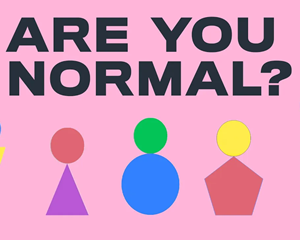In 1945, two sculptures meant to represent the average man and woman in the United States went on exhibit at the American Museum of Natural History.
1945年,两座旨在代表美国普通男性容貌和女性的雕塑,在美国自然历史博物馆展出。
Based on measurements taken from tens of thousands of young men and women, they were called Norma and Normman.
两座雕塑的容貌基于数以万计青年男女的测量数据,它们被命名为“诺玛”和“诺曼”。
That same year, a contest launched to find a living embodiment of Norma.
人们在同年发起一场比赛,试图找到“诺玛”的真人原型。
Normal is often used as a synonym for "typical," "expected," or even "correct."
“正常”通常被用作“典型的”和“意料之中的”,甚至是“正确的”的同义词。
By that logic, most people should fit the description of normal.
以这种逻辑来看,大部分人都应该符合正常的描述。
And yet, not one of almost 4,000 women who participated in the contest matched Norma, the supposedly "normal" woman.
然而,在将近4000名参加比赛的女性里,没有一个人和诺玛,人们想象中“正常”的女性相符。
This puzzle isn't unique to Norma and Normman, either -- time and time again,
这个令人费解的现象不仅出现在诺玛和诺曼中。
so-called normal descriptions of our bodies, minds, and perceptions have turned out to match almost no one.
不止一次那些对我们身体、思想和感受的所谓“正常描述”却几乎不符合任何人。
And yet, a lot of the world is constructed around a foundation of normalcy.
然而,大部分的世界都是围绕着正常的基础而构建的。
So what does normal actually mean -- and should we be relying on it so much?
正常实际上意味着什么?我们应该如此依赖这个概念吗?
In statistics, a normal distribution describes a set of values that fall along a bell curve.
从统计学看,一个正常的正态分布图描述的是落在钟形曲线上的一组数值。
The average, or mean, of all the values is at the very center, and most other values fall within the hump of the bell.
在最中心的是所有数值的平均值,大部分的其他数值都落在钟形的驼峰内。
These curves can be tall, with most values inside a narrow range, or long and flat, with only a slight bias towards the average.
如果曲线高耸,则大部分数值集中在一个很窄的范围内,曲线低平则说明数值和平均值间仅有微小差距。
What makes the distribution normal is that it follows this curved shape.
决定数据分布正常与否的是其是否遵循这个弯曲的曲线形态。
Normal doesn't describe a single data point, but a pattern of diversity.
正常描述的不是单一的一点,而是一组多元的数据。
Many human traits, like height, follow a normal distribution.
人类的许多特质,例如身高就符合正态分布。
Some people are very tall or very short, but most people fall close to the overall average.
有的人很高,有的人很矮,但大部分人都很接近总平均值。
Outside of statistics, normal often refers to an average
在统计学以外,正常一般指的是平均值,
like the single number pulled from the fattest part of the bell curve that eliminates all the nuance of the normal distribution.
如从钟形曲线最宽厚部分抽出的单一数字一样,它消除了正态分布中的所有细微差别。

Norma and Norman's proportions came from such averages.
诺玛和诺曼的比例正是来自于这样的平均值。
Applied to individuals, whether someone is considered normal usually depends on how closely they hew to this average.
对于个体来说,一个人被认为是否正常,通常取决于他们与平均值的接近程度。
At best, such definitions of normal fail to capture variation.
该种对正常的定义无法捕捉变量。
But oftentimes, our calculations of normal are even more flawed. Take the BMI -- or Body Mass Index.
然而通常情况下,我们对于正常的估算甚至存在更大的缺陷。以BMI(体质指数)为例。
BMI is a measure of weight relative to height, with different ratios falling into "underweight," "normal weight," "overweight," and "obese" ranges.
BMI是一种相对于身高的体重测量,不同的比例决定着一个人是在“过瘦”、“正常体重”、“超重”或是“肥胖”的范围内。
Generally, only BMIs that correspond to normal weight are considered healthy.
通常来说,只有BMI指数符合正常体重才会被视为健康。
But BMI is not always an accurate predictor of health, or even of what's a healthy weight.
但BMI指数并不总能准确地预测健康,甚至什么是一个健康的体重。
BMI doesn't take into account body fat percentage, body fat distribution, levels of physical activity, or blood pressure.
BMI没有考虑到体脂率、体脂肪分布、运动的频率或者血压。
And yet, those who fall outside the so-called normal range are commonly advised that losing or gaining weight will improve their health.
然而,却普遍建议在正常数值以外的人们减重或是增重,去提高他们的健康水平。
When we apply a standard of normal to all of humanity that's based on data from a non-representative slice,
当我们用一个正常的标准来衡量全人类,而衡量正常的标准来自于不具代表性的切片中的数据,
we're not just choosing one point on the distribution, we're choosing it from the wrong distribution.
我们不只是在分布上选择了某个值,我们更是在错误的分布上选择了它。
A lot of behavior science research draws from samples that are pretty WEIRD -- meaning Western, educated, industrialized, rich, and democratic.
许多的行为科学研究使用的样本都十分“奇怪”,意思是这些样本都是来自西方的、受到良好教育的、工业化的、富有的和民主的。
These features can skew norms even in research that doesn't have an obvious link to them.
这些特征可以改变常态,甚至在这些特征和研究上没有明显关联时。
Take the famed Muller-Lyer optical illusion: it's normal to think one of the two lines is longer, when they're actually the same length.
以著名的穆勒-莱尔错觉举例,人们通常认为其中一条线比另一条长,但是它们其实是一样长的。
At least, it is if you're an American undergraduate.
至少对一个美国大学生来说是这样的。
A team of anthropologists and psychologists found other demographic groups were much less susceptible
一个由人类学家和心理学家组成的团队发现,其他地域的人们受错觉影响的可能性要小得多,
members of the San people of the Kalahari weren't susceptible to the illusion at all.
像是卡拉哈里地区的桑人,他们完全不受错觉的影响。
When these limited or inaccurate definitions of normal are used to make decisions that impact people's lives, they can do real harm.
当这些有限或是不准确对正常的定义,被用来制定影响人们生活的政策,这可以导致真实的伤害。
Historically, such concepts of normal have been hugely influential.
历史上,关于正常的定义有深大的影响性。
The Eugenics Movement of the early 20th century weaponized the concept of normal,
像是20世纪初的优生运动使用正常的定义作为武器,
using it to justify exclusion, violence, and even extermination of those deemed not normal.
用来合理化排斥、暴力伤害、甚至灭绝那些被认为不正常的人。
To this day, people are often targeted and discriminated against on the basis of disabilities, mental health issues, sexual orientations, gender identities, and other features deemed "not normal."
时至今日,人们常受到攻击和歧视,因为他们的精神问题、性取向、性别认同和其他被认为“不正常”的特征。
But the reality is that the differences in our bodies, minds, perceptions, and ideas about the world around us -- in short, diversity -- is the true normal.
事实上,这只是我们身体、思想、认知和对周围世界的想法上的差别,简而言之,多样性才是真正的“正常”。


